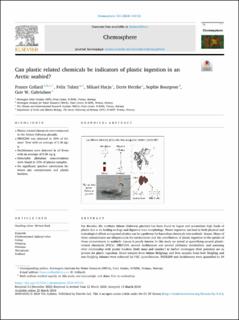| dc.contributor.author | Collard, France | |
| dc.contributor.author | Tulatz, Felix | |
| dc.contributor.author | Harju, Mikael | |
| dc.contributor.author | Herzke, Dorte | |
| dc.contributor.author | Bourgeon, Sophie | |
| dc.contributor.author | Gabrielsen, Geir Wing | |
| dc.date.accessioned | 2024-04-09T08:54:56Z | |
| dc.date.available | 2024-04-09T08:54:56Z | |
| dc.date.created | 2024-04-01T16:23:00Z | |
| dc.date.issued | 2024 | |
| dc.identifier.citation | Chemosphere. 2024, 355, 141721. | en_US |
| dc.identifier.issn | 0045-6535 | |
| dc.identifier.uri | https://hdl.handle.net/11250/3125449 | |
| dc.description.abstract | For decades, the northern fulmar (Fulmarus glacialis) has been found to ingest and accumulate high loads of plastic due to its feeding ecology and digestive tract morphology. Plastic ingestion can lead to both physical and toxicological effects as ingested plastics can be a pathway for hazardous chemicals into seabirds' tissues. Many of these contaminants are ubiquitous in the environment and the contribution of plastic ingestion to the uptake of those contaminants in seabirds’ tissues is poorly known. In this study we aimed at quantifying several plastic-related chemicals (PRCs) -PBDE209, several dechloranes and several phthalate metabolites- and assessing their relationship with plastic burdens (both mass and number) to further investigate their potential use as proxies for plastic ingestion. Blood samples from fulmar fledglings and liver samples from both fledgling and non-fledgling fulmars were collected for PRC quantification. PBDE209 and dechloranes were quantified in 39 and 33 livers, respectively while phthalates were quantified in plasma. Plastic ingestion in these birds has been investigated previously and showed a higher prevalence in fledglings. PBDE209 was detected in 28.2 % of the liver samples. Dechlorane 602 was detected in all samples while Dechloranes 601 and 604 were not detected in any sample. Dechlorane 603 was detected in 11 individuals (33%). Phthalates were detected in one third of the analysed blood samples. Overall, no significant positive correlation was found between plastic burdens and PRC concentrations. However, a significant positive relationship between PBDE209 and plastic number was found in fledglings, although likely driven by one outlier. Our study shows the complexity of PRC exposure, the timeline of plastic ingestion and subsequent uptake of PRCs into the tissues in birds, the additional exposure of these chemicals via their prey, even in a species ingesting high loads of plastic. | en_US |
| dc.language.iso | eng | en_US |
| dc.rights | Navngivelse 4.0 Internasjonal | * |
| dc.rights.uri | http://creativecommons.org/licenses/by/4.0/deed.no | * |
| dc.title | Can plastic related chemicals be indicators of plastic ingestion in an Arctic seabird? | en_US |
| dc.title.alternative | Can plastic related chemicals be indicators of plastic ingestion in an Arctic seabird? | en_US |
| dc.type | Peer reviewed | en_US |
| dc.type | Journal article | en_US |
| dc.description.version | publishedVersion | en_US |
| dc.rights.holder | © 2024 The Authors. Published by Elsevier Ltd. | en_US |
| dc.source.volume | 355 | en_US |
| dc.source.journal | Chemosphere | en_US |
| dc.identifier.doi | 10.1016/j.chemosphere.2024.141721 | |
| dc.identifier.cristin | 2257786 | |
| dc.relation.project | Norges forskningsråd: 275172 | en_US |
| dc.relation.project | Norges forskningsråd: 317386 | en_US |
| dc.relation.project | Framsenteret: PA072018 | en_US |
| dc.relation.project | NILU: 120138 | en_US |
| dc.relation.project | NILU: 121010 | en_US |
| dc.source.articlenumber | 141721 | en_US |
| cristin.ispublished | true | |
| cristin.fulltext | original | |
| cristin.qualitycode | 1 | |

